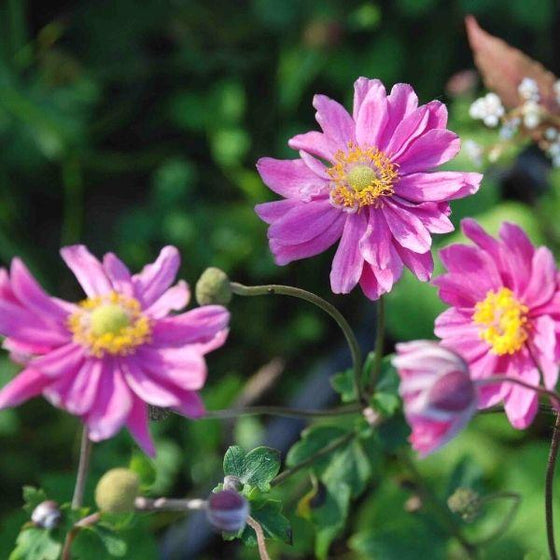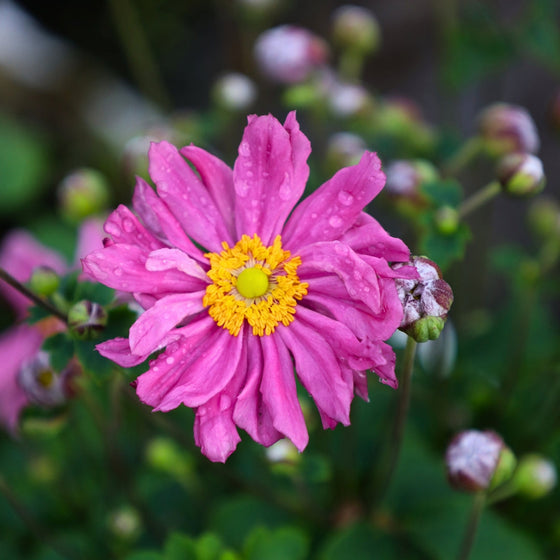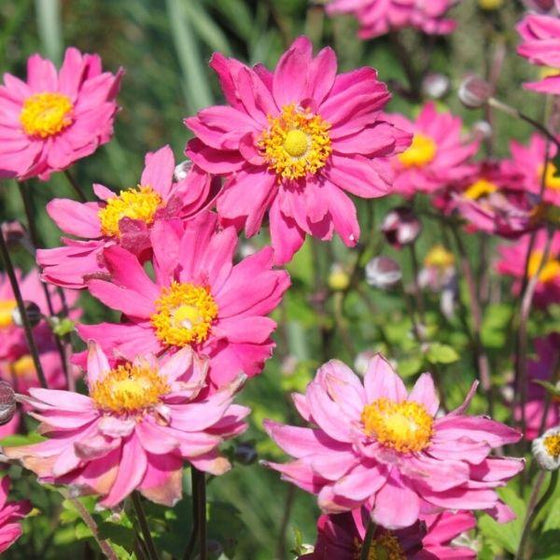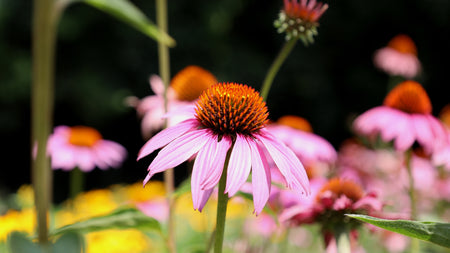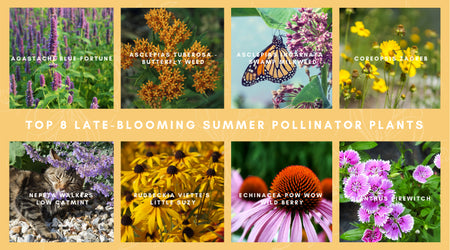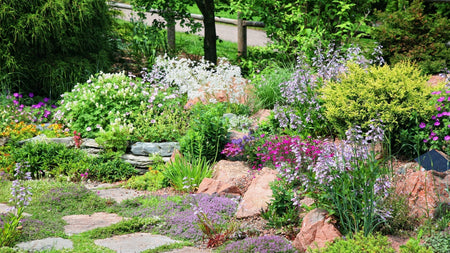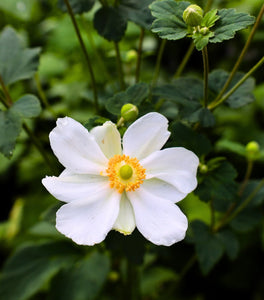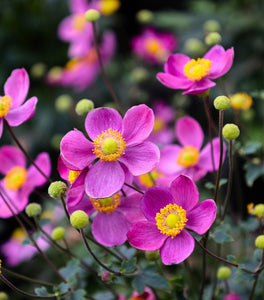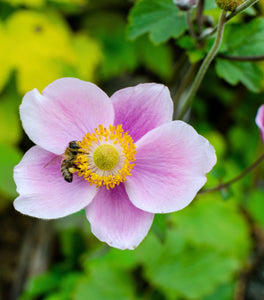
Images Depict Mature Plants
Anemone Pamina Windflower
Anemone ‘Pamina’, also known as Japanese Anemone, is a striking, late-blooming perennial prized for its rich, rosy-pink semi-double blooms that brighten up the fall garden. Blooming from late summer into early autumn, this elegant plant produces 2- to 3-inch flowers with golden-yellow centers that rise gracefully above dark green, deeply divided foliage. Anemone Pamina adds soft color, movement, and pollinator appeal to garden beds when most summer perennials are fading, making it a standout choice for extending seasonal interest.
Thriving in part sun to full shade and moist, well-drained soil, Pamina Anemone reaches a mature height of 24 to 30 inches, forming tidy clumps that gradually spread via rhizomes. It's an excellent choice for woodland gardens, shaded borders, cottage-style plantings, and even as a filler between shrubs in perennial beds. Once established, this hardy perennial is deer- and rabbit-resistant, making it ideal for gardens in areas with browsing wildlife. It's also low-maintenance and adapts well to a variety of soil types, especially when enriched with compost or organic matter.
Anemone ‘Pamina’ is perfect for gardeners looking to add late-season color and elegance to the landscape while supporting beneficial pollinators like bees and butterflies. Pair it with fall-blooming companions like asters, ornamental grasses, or sedums for a showstopping display. Whether used as a feature in a shaded corner or massed along woodland paths, Pamina Japanese Anemone delivers dependable beauty and timeless charm in every fall garden.
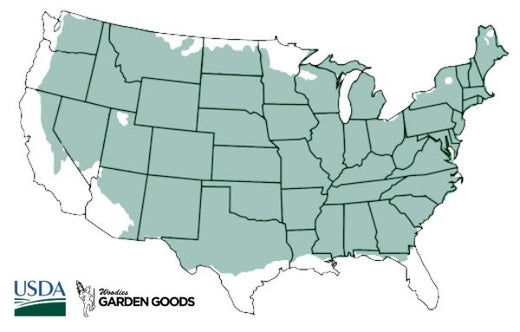
| Hardiness Zone: | 4-8 |
|---|---|
| Mature Height: | 2 to 2.5 Feet |
| Mature Width: | 2 to 2.5 feet |
| Classification: | Flowering Perennial |
| Sunlight: | Full Sun to Part Shade |
| Habit: | Upright, clump forming |
| Flower Color: | Rose pink with Yellow Center |
| Flowering Season: | Late Summer through Fall |
| Foliage: | Green |
| Soil Condition: | Any Average Garden Soil |
| Water Requirements: | Water well until established |
| Uses: | Extremely attractive when used in the mixed border, mass planting. Attracts pollinators and hummingbirds |
How to Care for Anemone Pamina
Before you purchase your Anemone Pamina plant, be sure to read our care instructions to ensure your plants remain happy and healthy for years to come.
How Do I Plant My Anemone Pamina?
To plant your Anemone Pamina, choose a location with partial shade to full sun and well-drained, organically rich soil. Begin by loosening the soil to a depth of 10–12 inches and mixing in compost or well-rotted manure to improve fertility and drainage. Space plants about 18–24 inches apart to allow for mature growth and good air circulation. When planting nursery-grown container specimens, dig a hole as deep and twice as wide as the root ball. Place the plant in the hole so the crown sits level with the surrounding soil, then backfill and gently firm the soil around the roots. Water thoroughly after planting to help establish strong roots, and mulch with 2–3 inches of organic material to retain moisture and suppress weeds. Anemone Pamina thrives in consistently moist soil, so be sure to keep the area evenly watered, especially during the first growing season. Avoid planting in areas prone to standing water, as overly wet conditions can lead to root rot. With proper care, your Anemone Pamina will provide beautiful late-summer to fall blooms, adding vibrant pink color and pollinator appeal to mixed borders, cottage gardens, and shade beds.
How Do I Water my Anemone Pamina?
Watering your Anemone Pamina correctly is essential for healthy growth and long-lasting blooms. During the first growing season, keep the soil consistently moist by watering deeply once or twice a week, depending on weather conditions. Aim to provide about 1 inch of water per week, either through rainfall or supplemental watering. Water at the base of the plant early in the morning to reduce the risk of fungal issues, and avoid wetting the foliage whenever possible. Consistent moisture is especially important during hot or dry spells to support bud formation and prevent stress. Once established, Anemone Pamina becomes moderately drought-tolerant but will perform best with regular watering during dry periods. Apply a layer of mulch around the base to retain soil moisture and regulate temperature, reducing the need for frequent watering. Be cautious not to overwater, as soggy or poorly drained soil can lead to root rot. Regular, balanced moisture helps this hardy perennial produce an abundance of its signature rosy-pink blooms from late summer into fall, making it a standout in pollinator-friendly borders and shade gardens.
How Should I Fertilize My Anemone Pamina?
Fertilizing your Anemone Pamina properly will help promote vigorous growth and abundant late-season blooms. In early spring, apply a balanced slow-release fertilizer—such as a 10-10-10 or 5-10-5 blend—according to the product’s instructions. Scatter the fertilizer evenly around the base of the plant, keeping it a few inches away from the crown, and water thoroughly to help nutrients soak into the soil. For an organic option, incorporate compost or well-rotted manure into the top layer of soil to improve fertility and support soil structure. During the growing season, you can supplement with a diluted liquid fertilizer every 4–6 weeks to boost flowering, especially if the plant is in lean soil. Avoid excessive nitrogen, which can lead to lush foliage but fewer blooms. A mid- to late-season feeding with a bloom-boosting formula high in phosphorus will help extend the flower display into fall. Fertilizing Anemone Pamina consistently not only enhances its floral performance but also supports a healthier root system and greater resistance to stress, making it a reliable choice for mixed borders, pollinator gardens, and shady perennial beds.

How and When Should I Cut Back My Anemone Pamina Plants?
Cutting back your Anemone Pamina at the right time helps maintain a tidy appearance and encourages healthy growth for the next season. In late fall, after the plant has finished blooming and the foliage begins to yellow or die back naturally, you can trim the stems down to just a few inches above ground level. This fall cut-back helps prevent the spread of disease and keeps the garden clean over winter. Be sure to use clean, sharp pruners and discard any diseased foliage rather than composting it to avoid contamination. If you prefer to leave the seed heads for winter interest or wildlife, you can delay cutting back until early spring. When new growth begins to emerge, remove any remaining dead stems and leaves to make room for fresh shoots. Throughout the growing season, feel free to deadhead spent blooms to encourage additional flowering and prevent unwanted self-seeding. Regular maintenance and seasonal pruning will keep Anemone Pamina thriving and ensure it returns year after year with its signature rosy-pink blooms lighting up your late-summer landscape.

